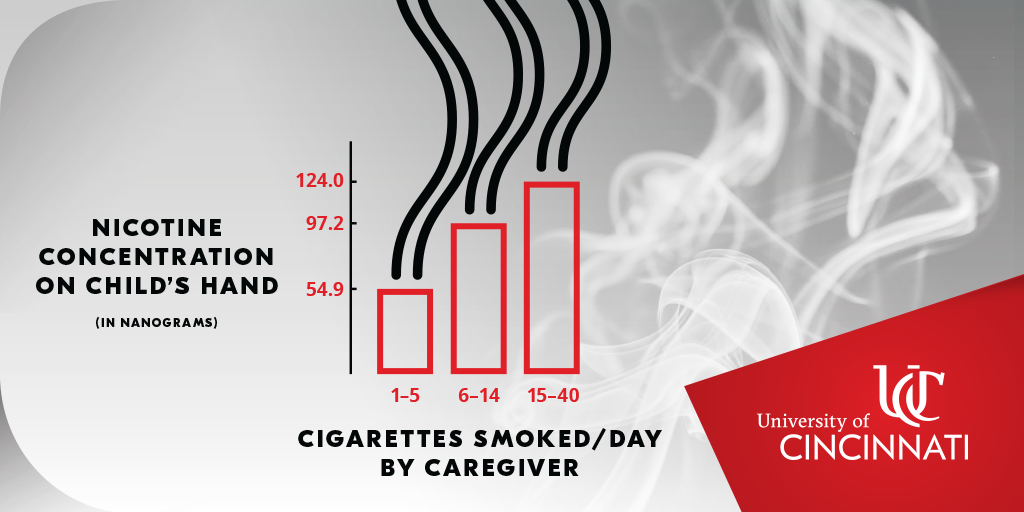Even smoking outside doesn’t stop exposure to smoke residue

Bans on smoking inside aren’t doing as much to protect children as previously thought, researchers from Cincinnati Children’s Hospital Medical Centre, and the University of Cincinnati have found, showing the lingering nicotine on the fingers of smokers is placing children at risk.
The findings will be of interest to those working in the early childhood education and care (ECEC) sector, with many educators leaving the ECEC premises to smoke, returning to the centre to care for children.
Researchers at Cincinnati Children’s Hospital Medical Center and the University of Cincinnati (UC) found evidence of the potentially harmful effects of exposure to the residue and particles left behind by tobacco smoke. In Nicotine on Children’s Hands: Limited Protection of Smoking Bans and Initial Clinical Findings, Cincinnati Children’s attending physician Melinda Mahabee-Gittens and UC assistant professor Ashley Merianos found that not smoking around children doesn’t stop the children of smokers from being exposed to nicotine.
They also found that that higher levels of exposure to tobacco smoke residue — which likely includes carcinogenic tobacco-specific nitrosamines — may be linked to respiratory problems.
“Indoor smoking bans don’t necessarily protect children from tobacco smoke exposure and related pollutants,” Ms Merianos said.
“Our research also shows that exposure to tobacco smoke toxicants is more widespread than previously thought because exposure in children is not limited to inhaling secondhand smoke,” added Ms Mahabee-Gittens, who is also a professor of pediatrics at the UC College of Medicine.
Researchers collected wipes of the dominant hands of 104 children visiting the Cincinnati Children’s Pediatric Emergency Department between April 2016 and August 2017 with complaints potentially linked to tobacco smoke exposure and who had at least one caregiver who smoked. The hand wipes were then analysed for nicotine.
The research explored several variables, including the self-reported smoking behaviors of the children’s caregivers, as well as the number of smokers living with the child, the number of cigarettes per day smoked by caregivers, the number of cigarettes smoked around the child in any location (such as in the home and the car) and the number of cigarettes smoked around the child inside the home. The research also looked at the medical records of the children for possible smoke exposure-related complaints such as wheezing and cough, as well as past medical histories and discharge diagnoses.
The study found significant levels of nicotine on the hands of children of smokers whose caregivers did not smoke in their presence, averaging 82 nanograms (ng) of nicotine.
A similar amount was found on the hands of children whose caregivers smoked between one and five cigarettes per day in their presence. Children whose parents smoked 15 or more cigarettes around them had nicotine levels on their hands in excess of 200 ng.
More than half of the children in the study were under two years old. Children in that age group averaged about 69 ng nicotine, while children between the ages of two and four — who accounted for 25 percent of the children studied — averaged nearly three times as much (185.6 ng). Children ages five and over were found to have only slightly more nicotine on their hands than the children under two.
“Future work should explore the associations of hand nicotine and age to determine how children’s changing interactions with their environment and behaviors contribute to increased nicotine in two- to four-year-olds, whether hand washing decreases the risk and whether increased levels are associated with increased [secondhand smoke-related] clinical illnesses,” researchers said.

Children whose caregivers smoked five or less cigarettes per day had an average of about 55 ng nicotine on their hands, while children whose caregivers smoked 15 or more per day were found to have an average of 124 ng nicotine on their hands.
Children with higher levels of nicotine found on their hands were significantly more likely to have respiratory symptoms such as wheezing and coughing, Ms Merianos said.
Ms Merianos advocates for caregivers, including those working with children in the ECEC sector, to quit smoking to decrease the exposure of children to nicotine and smoking-related chemicals. For those who do not quit, she recommends handwashing, showering and changing clothes after smoking to minimise thirdhand smoke exposure.
Ms Mahabee-Gittens adds that smokers should know that the measures outlined above are not enough to protect their children since deep-seated reservoirs of toxicants continue to build when smoking continues.
The study is available to review here.
Popular

Workforce
Policy
Quality
Practice
Provider
Research
ECEC must change now, our children can’t wait for another inquiry
2025-07-02 07:47:14
by Fiona Alston

Events News
Workforce
Marketplace
Practice
Quality
Provider
Research
An exclusive “Fireside Chat” with ECEC Champion Myra Geddes
2025-07-01 11:25:05
by Fiona Alston

Workforce
Practice
Provider
Quality
Research
Supporting successful transitions: Big moves, big feelings
2025-06-26 11:00:30
by Fiona Alston











